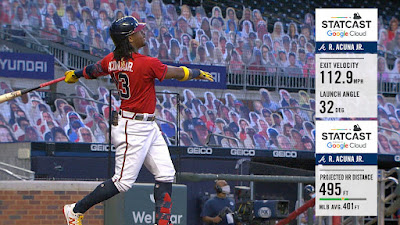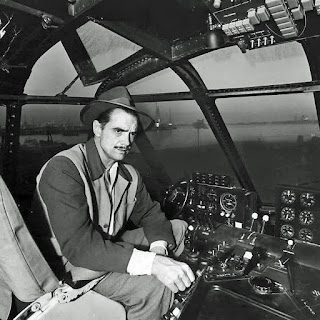SCIENCE25- The Science of Baseball's Home Run
There are more and more statistics used in calling Major League Baseball (MLB) games today, including those that measure the efficiency of the teams and the players, almost overwhelming the broadcast. This is particularly true for describing home runs, where it is common to immediately state the exit velocity and the launch angle, followed by the estimated home run distance, and endless analysis.
Home runs have always been
fascinating to the baseball fan. There
are two aspects of home runs that are particularly fascinating to me: 1) What are the factors that determine home
run distance and how do they work, i.e., what is the science of the home run,
and 2) What is all the ruckus about torpedo bats, that are supposed to
increase a batter’s home run proficiency?
I will list my primary sources at
the end.
Introduction
The concept of a home run in baseball
evolved over time, initially referring to a batter circling all the bases
after hitting the ball without being put out, often involving inside-the-park
runs. (In the early days - pre-1870s -
baseball fields often had large, open, irregular outfields, making
inside-the-park home runs more common. A batter could run around the
bases before the ball could be thrown in, resulting in a home run. As
ballparks became more defined and outfield fences or walls were built, the
concept of a home run shifted towards hitting the ball over the outfield fence
or wall, and there were fewer inside-the-park home runs. After World War
I, the baseball itself changed, becoming “livelier” due to improvements in
materials and manufacturing. This led to a significant increase in the
number of home runs hit.
Just to be clear, I’m going to talking about home runs that occur, when a batter
hits a fair ball and scores on the play without being put out or without
benefit of an error. In almost every
instance of a home run in MLB today, a batter hits the ball in the air over the
outfield fence or wall in fair territory.
Home run distance is the linear distance from home plate
to the point where the ball lands, typically recorded in feet. When a batted ball hits a stadium artifact, like a high
wall or sign, the home run distance is not the actual distance the ball
traveled, but instead the projected home run distance, i.e., how far the ball
would have traveled if it hadn't been interrupted by the obstruction.
The
science of hitting a home run in baseball involves a complex interplay of
physics, aerodynamics, and even the environment. Here's a summary of the science behind home
runs and a breakdown of the key factors that are involved.
Exit Velocity, Launch Angle,
and Flight Time
Exit
Velocity. This refers to how fast the ball leaves the bat
after impact. Higher exit velocity generally leads to a longer hit.
Factors that influence exit velocity include how fast the pitcher throws
the ball, how fast the batter swings (bat speed), what particular wood the bat
is made of, and the point of contact on the bat.
Launch Angle. The vertical angle at which the ball leaves the bat
significantly impacts how far it travels. In a vacuum, the optimal launch
angle would be 45 degrees. However,
taking into account the mitigating factors discussed below, the optimal launch
angle, is typically between 25-35 degrees for power hitters, allowing the ball
to achieve the greatest distance.

Key factors in determining the distance of a home run.
Flight Time. The duration that the ball is in the air, can affect how wind and other
environmental factors influence its path.
Composition and Physics of
Bats
Bat Composition. In MLB, the required wooden bats must be a single piece of solid wood. They are usually made of a hard wood such as
maple, birch, or ash (hard woods transfer more energy to the baseball upon
impact than softer woods) for increased exit velocity. Traditionally they are made with ash
because these bats are flexible and lightweight with an open grain structure.
The
"Sweet Spot" and Bat Vibration. The sweet spot on a bat is the area where the most
energy is transferred to the ball, minimizing vibration and maximizing power. When the
ball hits this area, it deforms the bat slightly, and the bat recoils,
propelling the ball forward with maximum force. When the ball hits the
bat outside the sweet spot, the bat can vibrate, absorbing some of the energy
that could have been transferred to the ball. When a ball is hit
on the sweet spot, it feels solid and powerful to the batter, with the ball
traveling a greater distance.
While the exact
location of the sweet spot can vary depending on the bat's length, weight, and
design, it's typically found roughly 5 to 7 inches from the barrel's
end. You
can find the sweet spot by tapping different parts of the barrel with a ball
while holding the bat with a loose grip near the handle. The area with
the least vibration is the sweet spot.

Profile of a standard wooden bat.
I’ll have more about the composition
and physics of bats in Part 2.
Spin Rate
When
a baseball is hit with backspin, the air flowing over the ball moves faster
than the air flowing over the bottom of the ball. This creates higher air pressure below the
ball and produces an upward “lift” effect called the Magnus force, counteracting
gravity, helping the ball stay in the air longer, and increasing the distance
traveled. Trying to achieve backspin is why MLB batters
attempt to impact the ball on its lower half with an upward bat trajectory.

The Magnus force, created by backspin on a batted ball, produces longer home runs.
Research
suggests an optimal spin rate for maximizing distance of around 1500-2500 rpm,
while excessive spin (over 2500-3000 rpm) can lead to diminishing returns. Too much spin causes increased drag on the
ball, partially cancelling the lift generated.
The optimal spin rate is influenced by environmental factors that affect
air density, like altitude and temperature.
Topspin
has the opposite effect of backspin, increasing air resistance and producing a
downward force, that makes the ball drop faster and travel a shorter
distance.

Effect of spin rate on a nominal 350-foot home run.
Air
Resistance:
Air
resistance, also known as drag, is a major factor in limiting the distance a
baseball can travel. Drag slows down the
ball, causing it to reach a lower height and shorter horizontal distance than
it would in a vacuum. (A fly ball that
might travel around 700 feet in a vacuum would only carry about 400 feet with
air resistance.)

Example of the effect of air temperature on home run distance. Over the temperature range shown, the horizonal distance varies about 25 feet.
Air
resistance is affected by altitude, temperature, and humidity. At higher altitudes and temperatures, air
density is lower, resulting in less drag and allowing the ball to travel
further. Humid air is less dense than dry air, meaning a baseball will
experience less air resistance and travel farther in humid conditions.
In
general, cool and dry conditions, compared to hot and humid conditions, can
make a difference of 20-30 feet in home run distance.
Lower
air resistance at Coors Field in Denver (mile high altitude) is the reason home
runs travel about 5% farther than at near sea-level ball parks.
Wind
Wind is a very complex issue within a baseball stadium. It swirls around the stadium in difficult to
predict, chaotic patterns. Small changes
in wind speed or direction can create large changes in the local wind effects
at any given point within the park, making the effect of wind difficult to
account for.
A tailwind can
significantly increase home run distance, while a headwind can decrease
it.
 |
| Example of wind effect on home run distance. The 20-mph wind difference shown produces a distance variation of about 75 feet. |
Ballpark Playing
Field Dimensions and Obstructions
Each MLB ballpark has unique
playing field dimensions, making some parks more conducive to home runs than
others. Looking across all MLB
ballparks, the figure below shows a “composite” of the minimum and maximum
distances from home plate to the outfield fence or wall.

Mash-up of different MLB ballpark shortest and longest playing field dimensions, illustrating significant differences in home run opportunities.
There is no standard height for
outfield fences or walls in MLB ballparks, and they vary considerably, even
within the same stadium. Some fences or walls are relatively short
(around 4-8 feet), while others are quite tall, like the Green Monster
wall at Fenway Park, which is 37 feet high.
Also,
each ball park has its own set of artifacts or obstructions that could
interfere with the flight of a home run ball.
These include seats in the stands, upper deck perturbances, scoreboards,
signs, etc., making it harder to estimate the projected home run distance.
Calculating Home Run Distance
Traditional Methods. Historically, the distance of a
home run was estimated through visual approximations or basic
calculations. This often involved
measuring straight-line distances from home plate to the landing spot of the
ball, but these methods lacked precision.
Two primary techniques were
utilized:
1. Eyeball Estimation: In the early days of baseball, the distance was often
gauged by spectators and commentators, who would estimate how far the ball had
traveled based on their view of the field.
2.
Architectural Mapping: Over time, stadiums were mapped with precise
measurements of distances to various features. These maps allowed for more
accurate estimations of home run distances based on the known dimensions of the
field.
Advancements in Measurement
Technology. The advent of statcast changed everything. Statcast is
an automated tool developed for MLB to track and analyze various aspects of the
game, including pitches, hits, and player movements. Statcast was
introduced to all thirty MLB stadiums in 2015, and is licensed
to ESPN.
Statcast is a sophisticated baseball tracking system
that uses a combination of high-speed cameras and radar technology to
gather detailed data on every aspect of the game. This data provides a
wealth of information for teams, players, and fans.
Each MLB organization now has an analytics team, using statcast
data to gain a competitive advantage. This "arms race" of new data
that is becoming available from statcast is a rapidly growing field within MLB
teams in their "analytics" group.
In recent years, MLB has
embraced statcast technology to enhance the accuracy of home run distance
measurements. In the statcast system
today, multiple high-speed cameras are strategically placed around the ballpark
to track the movement of the ball, players, and even the bat. These
cameras capture precise details about the ball's trajectory, launch angle, and
spin rate. Radar systems are used to track the speed and trajectory of
the ball, particularly in relation to the pitcher and hitter.
Statcast operates by capturing
the ball's speed, launch angle, and trajectory immediately after it leaves the
bat. This information is processed to
create a detailed model of the ball’s flight path, allowing for a more accurate
calculation of the distance traveled. Key factors influencing home run distance, accounted
for in statcast's analysis, include exit velocity, launch angle, flight time, wind
speed and direction, temperature, humidity, altitude, and stadium playing field
dimensions and obstructions.
Statcast combines these data
points to generate a projected home run distance, accounting for variables that
traditional methods could not measure.

Example of statcast analysis for a home run.
Conclusions
Using detailed data as statcast
provides, MLB players have learned what the key factors are for producing home
runs. They study the data and train to
improve their home run performance. They
watch videos of their hitting approach and swing, and use virtual reality
simulations to make adjustments to improve home run success.
An increasing emphasis on home
runs in MLB, advanced technology to provide detailed analytical data, and
ballplayers’ efforts to improve home run performance have had dramatic
success. See the chart below.

Historical increase in MLB home runs per year.
I’ll close with some home run data from 2025. Here is a table summarizing the exit velocity
and launch angles for the top 10 longest MLB home runs of the 2025 season so
far, along with their respective distances:
|
Rank |
Player |
Distance (Feet) |
Exit Velocity (mph) |
Launch Angle (°) |
|
1 |
Mike
Trout |
484 |
115.4 |
26 |
|
2 |
Byron
Buxton |
479 |
111.6 |
25 |
|
3 |
Logan
O'Hoppe |
470 |
108.1 |
34 |
|
4 |
Aaron
Judge |
469 |
117.9 |
31 |
|
5 |
Aaron
Judge |
468 |
115.0 |
30 |
|
6 |
Ryan
McMahon |
467 |
112.0 |
30 |
|
7 |
Ronald
Acuña Jr. |
467 |
115.5 |
23 |
|
8 |
Kyle
Schwarber |
466 |
109.3 |
|
|
9 |
Eugenio
Suarez |
466 |
111.7 |
25 |
|
10 |
Christian
Yelich |
465 |
110.6 |
25 |
“Every strike brings me closer to the next home run.” - Babe Ruth
Sources
My principal sources include:
“How is Home Run Distance Measured?” platecrate.com; “Baseball bat” and
“statcast,” Wikipedia.com; plus, numerous other online sources. I am increasingly, and hopefully carefully,
using Google’s AI/ChatGPT summaries of searches, including for this blog, “the
science of home runs,” “calculating home run distance from exit velocity and
launch angle,” “quantitatively, what are air resistance and spin rate impact on
home run distance,” “what is the sweet spot on a baseball bat,” “how do people
estimating home run distance consider the unique characteristics of each ball
park construction,” “projectile range formula for baseball,” and “how does
statcast work.” These AI summaries
directed me to numerous additional specific sources.




Very interesting! We are big baseball fans and in 2015 we went to a game in each of the 30 ballparks. Took us about 3 months to get to all the parks. Started in AZ (of course, and opening day happened to be between the D'backs and our favorite for decades---starting in NY---the SF Giants), our last was in LA. Possibly the worst stadium in the MLB.
ReplyDelete